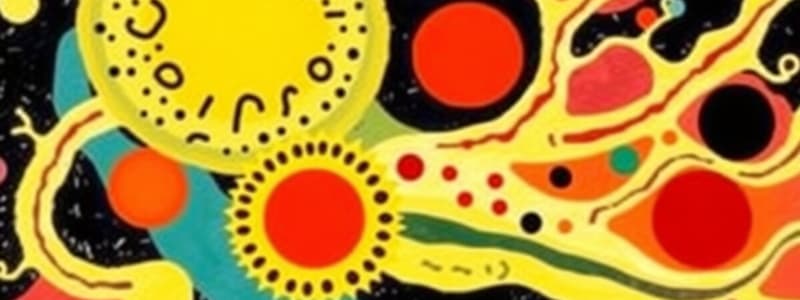Podcast
Questions and Answers
Which of the following statements about protists is NOT true?
Which of the following statements about protists is NOT true?
- Protists can be classified as animal-like or plant/fungus-like.
- All protists are microscopic and unicellular. (correct)
- Protists can exhibit various locomotion methods.
- Most protists have a nucleus and membrane-bound organelles.
What type of nutrition do diatoms exemplify?
What type of nutrition do diatoms exemplify?
- Saprophytic from decaying matter
- Heterotrophic via absorption
- Parasitic on other organisms
- Autotrophic through photosynthesis (correct)
Which type of reproduction is commonly observed in fungi?
Which type of reproduction is commonly observed in fungi?
- Binary fission
- Hydra budding
- Spores dispersal (correct)
- Meiotic cell division
Which of these ecological roles do protists NOT typically fulfill?
Which of these ecological roles do protists NOT typically fulfill?
What is the main structural component of fungal cell walls?
What is the main structural component of fungal cell walls?
Which statement accurately describes the relationship between fungi and animals?
Which statement accurately describes the relationship between fungi and animals?
What type of locomotion is predominantly associated with amoebas?
What type of locomotion is predominantly associated with amoebas?
Which of the following protists is noted for causing human diseases?
Which of the following protists is noted for causing human diseases?
What describes the nutritional mode of slime molds?
What describes the nutritional mode of slime molds?
In what way do some protists contribute to coral species?
In what way do some protists contribute to coral species?
Flashcards are hidden until you start studying
Study Notes
Characteristics of Protists
- Protists are eukaryotic organisms with a nucleus and membrane-bound organelles.
- Most protists are microscopic and unicellular; some are multicellular.
- Diverse locomotion methods include flagella, cilia, and pseudopods.
- Differentiated into animal-like (no cell walls) and plant/fungus-like (with cell walls).
- They represent a diverse group of organisms outside traditional categories of plants, animals, and fungi.
Habitat and Nutrition
- Found in a variety of environments including saltwater, freshwater, soil, and within hosts.
- Nutrition can be autotrophic (photosynthetic) or heterotrophic.
- Examples of autotrophic protists: diatoms and euglena.
- Common heterotrophic protists include amoebas, paramecia, and slime molds.
- Reproduction involves complex methods, including binary fission and sexual reproduction.
Ecological Impact
- Photosynthetic protists, like phytoplankton, are essential producers in aquatic ecosystems, contributing significantly to oxygen production and food webs.
- Decomposer protists, such as slime molds, are crucial for nutrient cycling in ecosystems.
- Many organisms, including corals, rely on protists for essential functions like carbon fixation.
- Some protists can cause diseases (e.g., malaria), highlighting their dual role in ecosystems.
- Ongoing research is focused on treatments for harmful protists and understanding their ecological impacts.
Fungal Characteristics
- Fungi are also eukaryotic organisms with distinct characteristics.
- Most fungi have chitin-based cell walls, similar to insect exoskeletons.
- Found in various habitats including soil, aquatic environments, and as part of human microbiota.
- Molecular genetics indicate fungi are more closely related to animals than to plants.
- Fungi are heterotrophs, obtaining nutrients by consuming organic matter.
Reproduction and Impact
- Fungi reproduce both sexually and asexually, often using spores for dispersal.
- Fungal infections can impact humans, leading to conditions such as yeast infections, ringworm, and athlete's foot.
- Many fungi act as parasites, impacting other organisms, including crops, and contributing to agricultural challenges.
- Play vital roles as decomposers, food sources, and symbiotic partners within ecosystems.
- Fungi contribute significantly to medicine; Penicillin and other antibiotics are derived from fungal sources.
Applications and Discoveries
- Both fungi and protists have significant applications in biotechnology and medicine.
- Research includes phytoplankton for biofuels, fungal biocontrol agents for pests, and yeast in various biotechnological applications.
- Continued scientific exploration of these organisms harbors potential for groundbreaking discoveries and advancements.
Studying That Suits You
Use AI to generate personalized quizzes and flashcards to suit your learning preferences.




